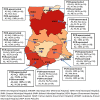Therapeutic efficacy of artesunate-amodiaquine and artemether-lumefantrine combinations for uncomplicated malaria in 10 sentinel sites across Ghana: 2015-2017
- PMID: 31234874
- PMCID: PMC6591907
- DOI: 10.1186/s12936-019-2848-1
Therapeutic efficacy of artesunate-amodiaquine and artemether-lumefantrine combinations for uncomplicated malaria in 10 sentinel sites across Ghana: 2015-2017
Abstract
Background: Routine surveillance on the therapeutic efficacy of artemisinin-based combination therapy (ACT) has been ongoing in Ghana since 2005. The sixth round of surveillance was conducted between 2015 and 2017 to determine the therapeutic efficacy of artesunate-amodiaquine (AS-AQ) and artemether-lumefantrine (AL) in 10 sentinel sites across the country.
Methods: The study was a one-arm, prospective, evaluation of the clinical, parasitological, and haematological responses to directly observed treatment with AS-AQ and AL among children 6 months to 9 years old with uncomplicated falciparum malaria. The WHO 2009 protocol on surveillance of anti-malaria drug efficacy was used for the study with primary outcomes as prevalence of day 3 parasitaemia and clinical and parasitological cure rates on day 28. Secondary outcomes assessed included patterns of fever and parasite clearance as well as changes in haemoglobin concentration.
Results: Day 3 parasitaemia was absent in all sites following treatment with AS-AQ whilst only one person (0.2%) was parasitaemic on day 3 following treatment with AL. Day 28 PCR-corrected cure rates following treatment with AS-AQ ranged between 96.7% (95% CI 88.5-99.6) and 100%, yielding a national rate of 99.2% (95% CI 97.7-99.7). Day 28 PCR-corrected cure rates following treatment with AL ranged between 91.3% (95% CI 79.2-97.6) and 100%, yielding a national rate of 96% (95% CI 93.5-97.6). Prevalence of fever declined by 88.4 and 80.4% after first day of treatment with AS-AQ and AL, respectively, whilst prevalence of parasitaemia on day 2 was 2.1% for AS-AQ and 1.5% for AL. Gametocytaemia was maintained at low levels (< 5%) during the 3 days of treatment. Post-treatment mean haemoglobin concentration was significantly higher than pre-treatment concentration following treatment with either AS-AQ or AL.
Conclusions: The therapeutic efficacy of AS-AQ and AL is over 90% in sentinel sites across Ghana. The two anti-malarial drugs therefore remain efficacious in the treatment of uncomplicated malaria in the country and continue to achieve rapid fever and parasite clearance as well as low gametocyte carriage rates and improved post-treatment mean haemoglobin concentration.
Keywords: Artemether–lumefantrine; Artesunate–amodiaquine; Ghana; Sentinel sites; Therapeutic efficacy; Uncomplicated malaria.
Conflict of interest statement
The authors declare that they have no competing interests.
Figures




References
-
- Ghana Statistical Service. Ghana multiple indicator cluster survey with an enhanced malaria module and biomarker, 2011, final report. Accra: Ghana Statistical Service; 2011. http://www2.statsghana.gov.gh/docfiles/publications/MICS4_MAIN_REPORT.pdf.
-
- Ghana Statistical Service. Ghana malaria indicator survey, 2016. Accra: Ghana Statistical Service; 2017. http://www2.statsghana.gov.gh/docfiles/publications/MIS26.pdf.
-
- Ghana Health Service . National Malaria Control Programme 2013 annual report. Accra: Ghana Health Service; 2014.
-
- Ghana Health Service. National Malaria Control Programme 2017 annual report. Accra: Ghana Health Service; 2018. http://www.ccmghana.net/index.php/strategic-plans-reports?download=200:n....
-
- Ghana Health Service . National Malaria Control Programme 2016 annual report. Accra: Ghana Health Service; 2017.
MeSH terms
Substances
Grants and funding
LinkOut - more resources
Full Text Sources
Molecular Biology Databases
Research Materials

